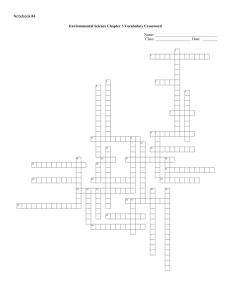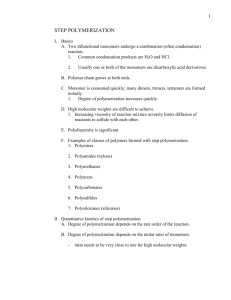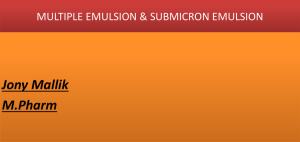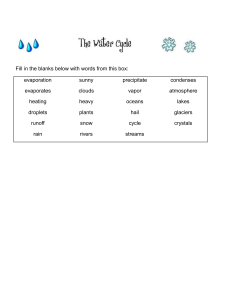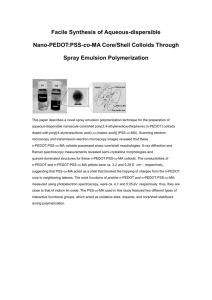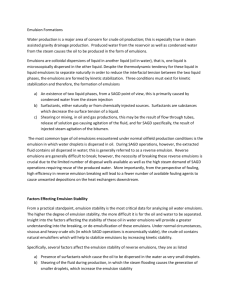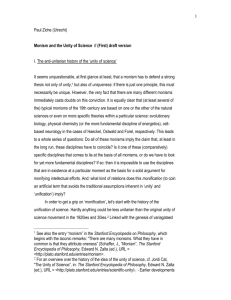Supporting information Impact of non
advertisement
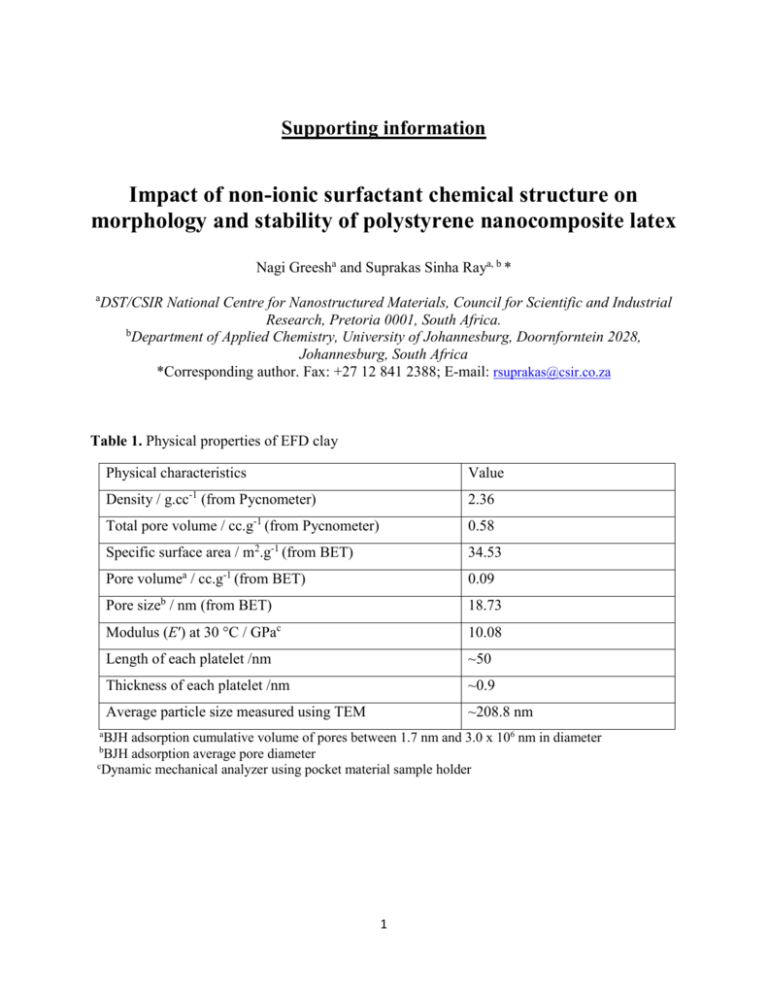
Supporting information Impact of non-ionic surfactant chemical structure on morphology and stability of polystyrene nanocomposite latex Nagi Greesha and Suprakas Sinha Raya, b * a DST/CSIR National Centre for Nanostructured Materials, Council for Scientific and Industrial Research, Pretoria 0001, South Africa. b Department of Applied Chemistry, University of Johannesburg, Doornforntein 2028, Johannesburg, South Africa *Corresponding author. Fax: +27 12 841 2388; E-mail: rsuprakas@csir.co.za Table 1. Physical properties of EFD clay Physical characteristics Value Density / g.cc-1 (from Pycnometer) 2.36 Total pore volume / cc.g-1 (from Pycnometer) 0.58 Specific surface area / m2.g-1 (from BET) 34.53 Pore volumea / cc.g-1 (from BET) 0.09 Pore sizeb / nm (from BET) 18.73 Modulus (E′) at 30 °C / GPac 10.08 Length of each platelet /nm ~50 Thickness of each platelet /nm ~0.9 Average particle size measured using TEM ~208.8 nm a BJH adsorption cumulative volume of pores between 1.7 nm and 3.0 x 106 nm in diameter b BJH adsorption average pore diameter c Dynamic mechanical analyzer using pocket material sample holder 1 Emulsion polymerization using non-ionic surfactants The morphology of the PS particles prepared with a low surfactant concentration was observed to be undefined, with large particle sizes and a broad particle size distribution. The use of these surfactants provides steric stability only and can result in latexes with large particles and broad particle size distributions. The dispersion obtained after polymerization was unstable, and phase separation occurred upon centrifugation at 5000 rpm for 30 min (Figure 1(a’ and c’) inset). This instability is caused by coalescence when two droplets combine after they have collided to form an aggregate. The rate of coalescence is dependent on the droplet encounter rate and the properties of the droplet surface. The average particle size varied within the range of 0.31.8 µm, depending on the concentration of the surfactants. As the concentration of the surfactants increased (from 0.7 to 2 wt.% relative to the monomer concentration), the diameter of the PS particles decreased from 1.8 to 0.3 µm. This is an expected result because the amount of surfactants is a determining factor in the stabilization of the newly nucleated particles, reducing their aggregation during the early stages of the growth process. Therefore, the number of formed nuclei increased with increasing surfactant concentration, which resulted in a large number of small particles. The tendency for particle size to decrease with increasing stabilizer concentration has been observed by other researchers [1,2,3]. However, as mentioned previously, the use of a large amount of surfactant is highly undesirable. The TEM images in Figure 1 (main text) also show that the morphology and the particles sizes of PS were not affected by the type of surfactant used, although the two surfactants have different chemical structures. On the other hand, Igepal®CO-630 behaves in a completely different manner during emulsion polymerization. Figure 2 (main text) show TEM images of the PS latex prepared by emulsion polymerization at two different concentrations (1.2 and 2 wt.% relative to monomer) of Igepal®CO-630. At a low surfactant concentration (Figure 2 (a&a’)), an unstable polymer latex (inset, Figure 2(a’)) was obtained due to molecular diffusion degradation, which results from the growth of larger monomer droplets at the expense of smaller droplets. This growth mechanism occurs due to the difference in the chemical potential between droplets of different radii [4,5]. The growth of droplets occurs by the molecular diffusion of monomers through the continuous phase. In other words, Ostwald ripening is a growth mechanism by which small particles effectively are 2 consumed by the larger particles [5-7]. As the concentration of Igepal®CO-630 increased from 1.2 to 2 wt.% relative to the monomer, the diameter of the PS particles decreased, as shown in Figure 2(b); however, Ostwald ripening persisted. During polymerization, the particle formation of the PS latexes was monitored by TEM. Figure 2(c & c’) shows TEM images of the PS latex formed after 3 h of polymerization; it is clear that the PS latex underwent Ostwald ripening during the early stages of polymerization. In oil-inwater emulsion polymerization, Ostwald ripening causes the diffusion of monomers from smaller to larger droplets due to the greater solubility of the single monomer molecules in the larger monomer droplets [7]. The rate of this diffusion process is linked to the solubility of the monomer in the continuous (water) phase of the emulsion, which can lead to the destabilization of emulsions (for example, by creaming and sedimentation) [5]. Ostwald ripening was observed to depend on the type of surfactants used. In the present study, the Ostwald ripening effect was not observed when Span®40 and Brij®S10 were used; only the use of Igepal®CO-630 caused Ostwald ripening. The reason for this behavior is not yet clear, but looks like it links with the chemical structure of the surfactants, which can affect the chemical potential of the droplets formed. For example, when Span®40 and Brij®S10 were used, the droplet encounter rate was faster than that when Igepal®CO-630 was used. Therefore, small particles aggregated to form large particles. Based on our previous discussions, coalescence and Ostwald repining cause monomer droplets to deform to form new, larger droplets, usually at the expense of smaller droplets. Therefore, to form a stable emulsion system, coalescence and Ostwald ripening must be suppressed, which can be achieved by an efficient emulsification procedure and by using a suitable type and amount of surfactant [6,8]. Recently, the literature has witnessed a dramatic increase in the number of studies investigating, in detail, the effect of Ostwald ripening and possible ways to suppress it [913]. For example, Davis et al [9] and Webster and Cates [10] reported that the addition of a lowvapor-pressure component that is completely soluble in the dispersed phase will significantly enhance the stability of emulsion systems. The presence of this soluble compound effectively creates an osmotic pressure inside droplets, which will prevent the diffusion of monomer from smaller to larger droplets. This work attempts to use organically modified clay to prevent or reduce the Ostwald ripening effect by suppressing monomer diffusion from smaller to larger droplets. 3 References 1. Chern CS (2006) Emulsion polymerization mechanisms and kinetics. Prog Polym Sci 31: 443486. 2. Binks BP, Lumsdon SO (1999) Stability of oil-in-water emulsions stabilised by silica particles. Phys Chem Chem Phys 1: 30073016. 3. Binks BP, Lumsdon SO (2000) Influence of particle wettability on the type and stability of surfactant-free emulsions. Langmuir 16: 86228631. 4. Soma J, Papadopoulos K (1996) Ostwald ripening in sodium dodecyl sulfate-stabilized decane-in-water emulsions. J Colloid Interface Sci 181: 225231. 5. Taylor P (1998) Ostwald ripening in emulsion. Adv Colloid and Interface Sci 75: 107163. 6. Welin-Berger K, Bergenstahl B (2000) Inhibition of Ostwald ripening in local anesthetic emulsions by using hydrophobic excipients in the disperse phase. Int J Pharm 200: 249260. 7. Zeeb B, Gibis M, Fischer L, Weiss J (2012) Influence of interfacial properties on Ostwald ripening in crosslinked multilayered oil-in-water emulsions. J Colloid Interface Sci 387: 6573. 8. Lin C, Wu J, Chern C (2013) Effects of the molecular weight of polymeric costabilizers on the Ostwald Ripening behavior and the polymerization kinetics of styrene miniemulsions. Colloid Surf A Phys Chem Eng Asp 434: 178184. 9. Davis SS, Round HP, Purewal TS (1981) J. Colloid Interface Sci. 80: 508511. 10. Webster AJ, Cates ME (1998) Stabilization of emulsions by trapped species. Langmuir 14:20682079. 11. Fontenot K, Schork F (1993) Sensitivities of droplet size and stability in monomeric emulsions. J Ind Eng Chem Res 32: 373385. 12. Voorhees PW (1985) The theory of Ostwald ripping. J Stat Phys 38: 231252. 13. Kuehmann C, Voorhees P (1996). Ostwald ripening in ternary alloys. Metall Mater Trans A 27: 937943. 4
